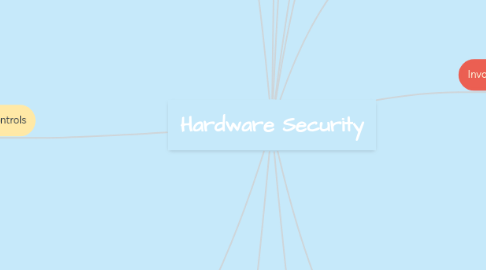
1. Administrative Controls
1.1. Fire Safety Factors
1.2. Interception of Data Protection
1.3. Mobile and Portable Device Control
1.4. Visitor Control
2. Hardware Device Overview
2.1. Input
2.1.1. Mouse
2.1.2. Keyboard
2.1.3. Readers
2.1.3.1. Barcode
2.1.3.2. Biometrics
2.1.3.2.1. Voice Recognition
2.1.3.2.2. Fingerprint
2.1.3.2.3. Facial
2.1.3.2.4. Hand
2.1.3.2.5. Iris
2.1.3.2.6. Retina
2.1.3.3. Card
2.1.4. Touch screen
2.2. Output
2.2.1. Visual Display Unit
2.2.2. Printers
2.2.3. Speech Output
2.3. Storage
2.3.1. Harddisk
2.3.2. USB
2.3.3. SSD
3. Prevention
3.1. Biometrics
3.1.1. Advantages
3.1.1.1. No Password
3.1.1.2. No Need ID Card
3.1.1.3. No Impersonation of Identity
3.1.1.4. Traits Cannot be Stolen or Duplicated
3.1.1.5. Hard to Break
3.1.1.6. Good Accuracy
3.1.1.7. Low Cost
3.2. ID Card and Badges
3.3. Photo ID Card
3.4. Magnetic Access Card
3.5. Locks and Keys
3.6. Electronic Monitoring and Surveillance Cameras
3.7. Alarms and Alarm Systems
3.8. Hardware Secure Module (HSM)
4. Implementation
4.1. Hardware Secure Module (HSM)
4.1.1. What?
4.1.1.1. physical computing device that safeguards and manages digital keys for strong authentication and provides cryptoprocessing
4.1.2. Critical Function
4.1.2.1. Encryption
4.1.2.2. Decryption
4.1.2.3. Authentication
5. Vulnerabilities
5.1. Theft
5.2. Human Intervention
5.2.1. Sabotage
5.2.2. Vandalism
5.2.3. Strikes
5.2.4. Intrusion
5.3. Disaster
5.3.1. Flood
5.3.2. Earthquake
5.3.3. Fire
5.3.4. Power Failure
5.4. Emergencies
5.4.1. Smoke
5.4.2. Building Collapse
5.4.3. Explosion
5.4.4. Water Leak
6. Aim
6.1. protection of information and property from theft, corruption, or natural disaster, while allowing the information and property to remain accessible and productive to its intended users
7. What?
7.1. measures taken to protect the physical environment and infrastructure that is housing the information system resources
8. IT Security?
8.1. Definition
8.1.1. protection of computer systems from the theft and damage to their hardware, software or information, as well as from disruption or misdirection of the services they provide.
8.2. Why?
8.2.1. to protect the business information value is the primary reason for information security
